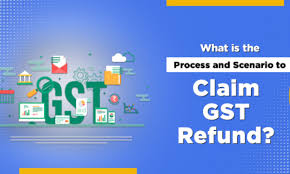How Much Time Is Taken for a GST Refund?

The implementation of the Goods and Services Tax (GST) in India brought a unified taxation structure and introduced a well-defined GST Refund Process. This process plays a crucial role in maintaining the liquidity of businesses, especially those that regularly deal in exports or have accumulated input tax credits. For businesses, understanding the time frame for receiving a GST refund is essential for planning their finances efficiently.
Refunds under GST arise in various scenarios, and while the process has become more streamlined with digital integration, delays still occur in certain cases. In this article, we will explore where to apply for a GST refund, how long it usually takes, the advantages of claiming it on time, types of GST refunds, and a step-by-step guide to help taxpayers navigate the process.
Where Is the GST Refund Applied?
The GST refund application must be submitted online through the GST portal. Businesses or individuals eligible for refunds are required to file Form GST RFD-01 within a specified time frame.
Here’s where and how to apply:
- Log in to the GST portal
- Navigate to: Services > Refunds > Application for Refund
- Select the relevant reason for the refund
- Upload the required supporting documents
- Submit Form GST RFD-01
Once the application is successfully submitted, an Application Reference Number (ARN) is generated. This ARN is essential for tracking the status of the refund application.
How Much Time Is Taken for a GST Refund?
As per the GST law, the time taken for a refund depends on the type of claim. Typically, a GST refund is processed within 60 days from the date of application. However, in some cases, provisional refunds may be granted within 7 days, especially for exporters.
Timeline Summary:
| Type of Refund | Time Frame |
| Provisional Refund (90% of claim) | Within 7 days of acknowledgment |
| Final Refund | Within 60 days of ARN generation |
| Refund with Incomplete Documents | Extended, based on document review |
| Delayed Refund | Interest @ 6% p.a. if beyond 60 days |
If the refund is not issued within the stipulated time, the government is liable to pay interest to the taxpayer, offering a fair and transparent approach.
Advantages of Timely GST Refunds
Timely processing of GST refunds provides several benefits to taxpayers, especially businesses:
- Improved Liquidity
A fast refund process ensures that working capital is not blocked, helping businesses maintain cash flow. - Better Financial Planning
With clarity on expected refund timelines, businesses can plan procurement, expansion, or loan repayments more efficiently. - Reduced Compliance Burden
Online submission and tracking ease the administrative burden of paperwork and follow-ups. - Transparency & Accountability
With interest liability for delayed refunds, the government is incentivized to process claims promptly.
Steps in the GST Refund Process
The GST Refund Process consists of the following key steps:
1. Filing the Refund Application (Form GST RFD-01)
- Log into the GST portal
- Select “Application for Refund”
- Choose the reason (e.g., excess tax payment, export without payment of tax, etc.)
- Fill Form GST RFD-01
- Upload relevant documents such as invoices, shipping bills, payment proof, etc.
2. Acknowledgment (Form GST RFD-02)
- After successful submission, an acknowledgment in Form GST RFD-02 is issued.
3. Provisional Refund (Form GST RFD-04)
- In the case of exporters, 90% of the refund is issued provisionally within 7 days.
4. Refund Scrutiny & Approval (Form GST RFD-06)
- GST officer scrutinizes the documents and issues an order approving or rejecting the refund.
5. Refund Payment (Form GST RFD-05)
- Once approved, a payment order is issued and the amount is credited to the applicant’s bank account.
6. Rejection or Deficiency Memo (Form GST RFD-08 or RFD-03)
- If the officer finds discrepancies, a show cause or deficiency memo is issued, requiring rectification.
Types of GST Refunds
The GST law provides for various types of refunds, depending on the nature of the transaction:
1. Excess Payment of Tax
Paid more tax than due? You can apply for a refund of the excess amount.
2. Export of Goods or Services
Exporters are eligible for a refund of the unutilized input tax credit or IGST paid on exports.
3. Inverted Duty Structure
If the rate of tax on inputs is higher than the rate on output, the excess input tax credit can be claimed as a refund.
4. Finalization of Provisional Assessment
Refund arises if the final tax assessment is lower than the provisional one.
5. Supplies to SEZ Units/Developers
Refund is granted on tax paid on supplies to Special Economic Zones.
6. Deemed Exports
Supplies treated as deemed exports under GST law are eligible for a refund.
Common Reasons for Delay in GST Refunds
Even though the process is designed to be efficient, delays may happen due to:
- Incorrect or incomplete filing of GST RFD-01
- Non-submission of supporting documents
- Errors in invoice matching
- System-related glitches on the GST portal
- Misclassification of refund type
- Departmental scrutiny taking longer than usual
To avoid such delays, businesses must ensure all information is accurate and documents are well-organized at the time of filing.
Conclusion
The GST Refund Process is a vital element of India’s indirect taxation system that ensures businesses are not burdened by blocked working capital. The government has tried to make the process efficient by introducing online filings, faster processing for exporters, and penalties for delays. While the standard time for a GST refund is 60 days, many claims are settled earlier—especially with correct documentation and compliance.
Taxpayers are encouraged to stay updated with GST rules and timelines to avoid errors that may result in refund rejections or delays. Engaging with professional tax consultants can also ensure a smooth and prompt refund experience.
Frequently Asked Questions
1. What is the standard time for receiving a GST refund?
The standard processing time is 60 days from the date of application (ARN generation). However, exporters may receive a provisional refund within 7 days.
2. How can I track the status of my GST refund?
You can track the refund status on the GST portal using your Application Reference Number (ARN) under the “Refunds” section.
3. What if my GST refund is delayed beyond 60 days?
If there is an unjustified delay, the government must pay interest at 6% p.a. to the applicant from the 61st day onwards.
4. Can I reapply if my refund is rejected?
Yes, if a deficiency memo is issued, you can rectify the errors and reapply with a fresh application.
5. Do I need a CA certification for refund claims?
Refund claims exceeding INR 2 lakhs must be accompanied by a Chartered Accountant’s certificate.
6. What documents are required for a GST refund?
Common documents include:
- Invoices
- Export shipping bills (for exporters)
- Bank realization certificates
- Input tax credit summary
- CA certification (if applicable)
7. Is the GST refund process completely online?
Yes, the entire process—from application to payment—is conducted online via the official GST portal.




